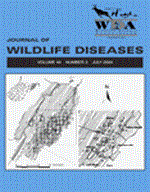An outbreak of West Nile virus (WNV) infection occurred at a captive breeding facility for the endangered eastern loggerhead shrike (Lanius ludovicianus migrans) in August 2002. Within 10 d, five birds died; two were found dead, and the others died shortly after showing neurologic signs. West Nile virus was detected in all organs examined using immunohistochemistry, and its viral genome was amplified from brain and kidney samples using reverse transcription–polymerase chain reaction. None of the remaining birds in the colony had antibodies against WNV, which suggests a mortality rate of 100%. After vaccination with a commercial equine WNV vaccine 31 of 37 (84%) of the birds had WNV neutralizing antibodies.
How to translate text using browser tools
1 July 2004
West Nile Virus Infection in the Eastern Loggerhead Shrike (Lanius ludovicianus migrans): Pathology, Epidemiology, and Immunization
Mads F. Bertelsen,
Rolf-Arne Ølberg,
Graham J. Crawshaw,
Antonia Dibernardo,
L. Robbin Lindsay,
Michael Drebot,
Ian K. Barker

Journal of Wildlife Diseases
Vol. 40 • No. 3
July 2004
Vol. 40 • No. 3
July 2004
Eastern loggerhead shrike
Flaviviridae
immunization
immunohistochemistry
Lanius ludovicianus migrans
RT-PCR
West Nile virus




